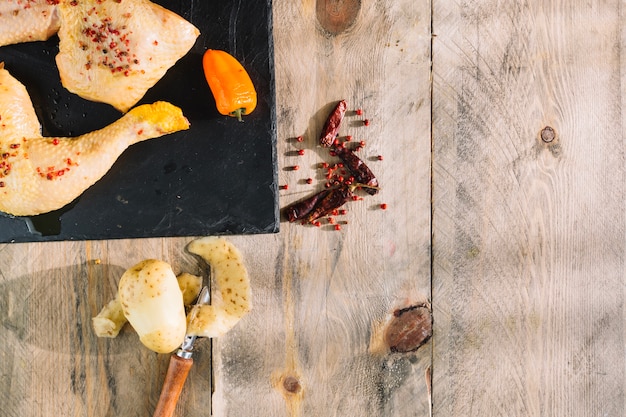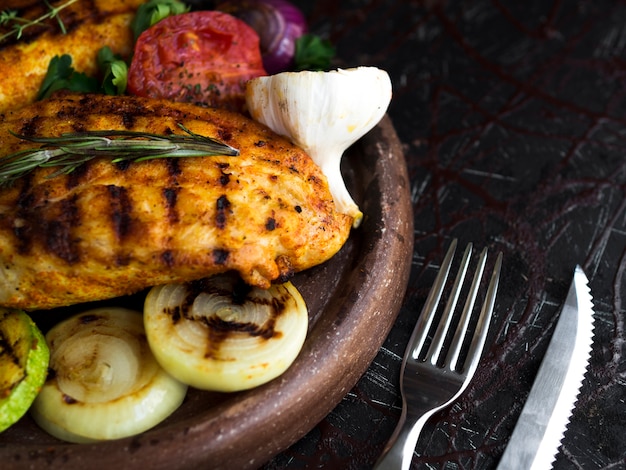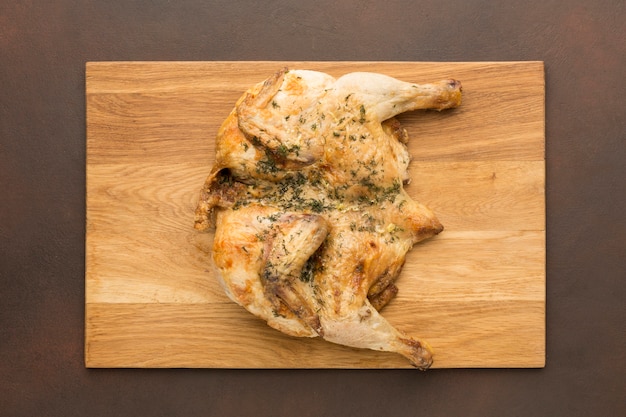Alright, let's get down to business and talk turkey, shall we? No, I'm not referring to those awkward family gatherings, but the delightful bird itself. Now, I've been a seasoned cook for years, and one thing I've learned is that nailing the right cooking temperature is paramount for a succulent, juicy turkey breast.
This guide is your one-stop shop for achieving that perfect turkey breast every time. We'll cover everything from selecting the right cut to understanding the science behind cooking temperatures. I'll even share some of my personal tips and tricks I've picked up over the years, gleaned from both successes and (admittedly, a few) culinary mishaps.
So, grab yourself a cuppa, settle in, and let's get cooking!
Part 1: Getting Started

Choosing the Right Turkey Breast
The first step is selecting the perfect turkey breast. You have a few options, but my go-to is a boneless, skin-on turkey breast. It's a breeze to cook and tends to retain its moisture beautifully. If you're feeling adventurous, a bone-in breast can be an option, but ensure you have a spacious roasting pan to accommodate it.
Prepping Your Turkey Breast
Now that you've secured your turkey breast, it's time to prep it for the oven. I always pat it dry with paper towels, giving it a thorough pat down. Then, I give it a good rub with olive oil, acting as a natural sealant, followed by my chosen seasoning. I usually go for a simple salt and pepper mix, but feel free to experiment with your favourite herb blends or even a dry rub for extra flavour.
Part 2: Understanding Cooking Temperatures

Here's where things get a bit scientific, but don't worry, I'll break it down for you.
The Science Behind It
The key to cooking a turkey breast perfectly is achieving the ideal internal temperature. You see, when you cook meat, the proteins transform, and water evaporates. Overcooking leads to a dry and tough texture.
The Safe Temperature
The most important thing to remember is that your turkey breast must reach a safe internal temperature of 165°F (74°C) to ensure it's cooked through and safe to eat. This temperature effectively eliminates any harmful bacteria lurking in the meat.
The Ideal Temperature
While 165°F (74°C) is the minimum safety threshold, it doesn't necessarily translate to the most delicious outcome. Aim for a temperature closer to 160°F (71°C) for a juicy, tender turkey breast. This is the sweet spot where the meat is cooked through but still retains its moisture and flavour.
Part 3: Cooking Your Turkey Breast

Alright, time to preheat those ovens!
oven roasting
This is my tried and true method for cooking a turkey breast. I typically preheat my oven to 325°F (160°C). I then place the turkey breast in a roasting pan, ensuring it's large enough to accommodate the breast comfortably. To maintain moisture, I always add a cup or two of water to the bottom of the pan. The steam created helps keep the turkey breast moist and tender.
roasting time
The roasting time for your turkey breast depends on its size. A general rule of thumb is about 20-30 minutes per pound. However, relying solely on time is risky. It's crucial to check the internal temperature with a meat thermometer to ensure it's cooked through.
Checking the Temperature
I always use a digital meat thermometer to check the internal temperature. Insert the thermometer into the thickest part of the breast, ensuring it doesn't touch any bones. The thermometer will provide an accurate reading of the internal temperature, allowing you to know when the breast is cooked to perfection.
Letting It Rest
Once your turkey breast reaches the desired temperature, it's essential to let it rest for at least 10 minutes before carving. This allows the juices to redistribute throughout the meat, resulting in a more succulent and tender turkey breast. Think of it as a post-workout recovery period for your turkey.
Part 4: Alternative Cooking Methods
Not everyone has an oven, or perhaps you're looking for a change of pace.
Pan-Searing
You can cook your turkey breast in a pan on the stovetop. Use a heavy-bottomed pan and sear it on all sides to achieve a beautiful, crispy crust. Finish it off in the oven to ensure it's cooked through. This method works particularly well for smaller turkey breasts.
slow cooking
For a more hands-off approach, consider slow cooking your turkey breast. This method produces a remarkably tender and juicy breast. Just ensure your slow cooker is large enough to accommodate your turkey breast comfortably.
Part 5: Tips and Tricks
Now, let's add a touch of magic with some tips and tricks I've learned over the years.
Brining
Brining is a fantastic way to enhance the juiciness and flavour of your turkey breast. It involves soaking the turkey breast in a saltwater solution for a few hours or overnight. The brine infuses the meat with moisture, preventing dryness and intensifying its flavour.
Stuffing
If you're feeling adventurous, you can stuff your turkey breast with your favourite stuffing. Be mindful not to overstuff it, as this can hinder even cooking.
Glazing
A glaze adds a beautiful shine and an extra layer of flavour to your turkey breast. A simple honey glaze is always a crowd-pleaser, but don't hesitate to get creative with different herbs and spices for a more personalised touch.
Resting
Remember, letting your turkey breast rest is crucial for achieving that melt-in-your-mouth tenderness and a burst of flavour.
Part 6: Serving Suggestions
Now, let's delve into the most enjoyable aspect – serving your beautifully cooked turkey breast!
Classic Sides
You can't go wrong with classic sides like mashed potatoes, gravy, stuffing, and cranberry sauce. They complement the turkey beautifully and add a touch of comfort to your meal.
Creative Sides
For a more adventurous approach, try pairing your turkey breast with roasted vegetables, salads, or even a fruit salsa. These options offer a refreshing contrast to the rich flavour of the turkey.
Gravy
A good gravy is an essential accompaniment for any turkey breast. You can make your own gravy using the pan drippings, adding depth of flavour. Or, opt for a store-bought variety if time is short.
Garnishing
A simple garnish like some fresh parsley or a sprig of rosemary elevates the presentation of your turkey breast. It adds a touch of visual appeal and fragrance to your dish.
Part 7: Troubleshooting
Okay, so you've followed all the instructions, but your turkey breast isn't quite turning out as envisioned. Let's troubleshoot some common issues:
Dry Turkey Breast
If your turkey breast is dry, it's likely that it was overcooked. Next time, try reducing the cooking time or using a lower temperature. Consider brining to prevent dryness as well.
Undercooked Turkey Breast
If your turkey breast is undercooked, you'll need to cook it for longer. Ensure you check the internal temperature with a meat thermometer to confirm it's safe to eat.
Unevenly Cooked Turkey Breast
If your turkey breast is unevenly cooked, it likely wasn't cooked evenly. Try using a smaller turkey breast or placing it on a rack in the roasting pan to allow air to circulate around it.
Part 8: Storage and Leftovers
Now, let's talk about keeping your turkey breast safe and delicious for later.
Storing Leftovers
Store leftover turkey breast in an airtight container in the refrigerator for up to 3-4 days. You can also freeze leftover turkey breast for up to 2-3 months.
Reheating Leftovers
To reheat leftover turkey breast, use the oven, microwave, or stovetop. Ensure it's heated through to an internal temperature of 165°F (74°C).
Part 9: Variations
Let's explore some variations on the classic turkey breast recipe.
Spiced Turkey Breast
Add a kick to your turkey breast by using a blend of spices like cumin, coriander, paprika, and cayenne pepper. These spices add depth of flavour and a subtle heat to your turkey breast.
Herbed Turkey Breast
Elevate your turkey breast with a medley of fresh herbs like rosemary, thyme, and sage. These herbs enhance the natural flavour of the turkey and create a more aromatic and flavorful dish.
smoked turkey Breast
If you have a smoker, achieve a smoky flavour by smoking your turkey breast for a few hours. This method imparts a unique smoky aroma and flavour to your turkey breast.
Part 10: FAQs
Here are some frequently asked questions about cooking turkey breast.
Q1: What's the difference between a turkey breast and a whole turkey?
A: A turkey breast is just the breast portion of the turkey, while a whole turkey includes the breast, wings, legs, and thighs. Turkey breasts are generally easier to cook and manage, making them a good option for smaller gatherings or if you prefer a leaner cut of meat.
Q2: Can I cook a frozen turkey breast?
A: It's best to thaw your turkey breast completely before cooking it. Cooking a frozen turkey breast can lead to uneven cooking and may not be safe. Thawing in the refrigerator is the safest method, allowing for slow and even thawing.
Q3: How do I know if my turkey breast is cooked through?
A: The best way to check if your turkey breast is cooked through is to use a meat thermometer. Insert the thermometer into the thickest part of the breast, ensuring it doesn't touch any bones. The internal temperature should reach at least 165°F (74°C).
Q4: Can I use a turkey breast for stuffing?
A: Yes, you can use a turkey breast for stuffing. Just make sure you don't overstuff it, or it might not cook evenly. A good stuffing technique is to stuff loosely, ensuring that the stuffing is not packed tightly, allowing for proper heat distribution and cooking.
Q5: How do I make gravy from turkey breast drippings?
A: To make gravy from turkey breast drippings, first, skim off any excess fat. Then, whisk in flour to thicken the drippings. Gradually add in broth or water, whisking constantly, until you reach your desired consistency. You can also add seasonings like salt, pepper, and herbs to taste. This creates a rich and flavorful gravy that complements the turkey breast beautifully.
And there you have it! Your comprehensive guide to cooking the perfect turkey breast. Remember, practice makes perfect, so don't be afraid to experiment and find what works best for you. Most importantly, enjoy the delicious results!
Everyone is watching

Corn on the Cob: The Ultimate Guide to Perfectly Cooked Ears
Healthy MealsAh, corn on the cob. Just the name evokes images of sunny days, barbecues, and that sweet, juicy flavour that ...

Perfect Pork Roast Oven Cooking Time: A Guide to Delicious Results
Healthy MealsThere's something truly satisfying about a perfectly roasted pork. The aroma alone is enough to make your mout...

Ham Cooking Time: How Long to Bake, Smoke, or Boil a Delicious Ham
Healthy MealsAh, ham. It's a classic, isn't it? A real crowd-pleaser, especially around holidays. And when done right, it'...

Scallops: The Ultimate Guide to Perfect Cooking
Healthy MealsAh, scallops. Those delicate, sweet, and utterly delicious morsels of the sea. They hold a special place in my...

Spaghetti Squash: The Ultimate Guide to Cooking and Serving
Healthy MealsRemember that time you saw spaghetti squash at the supermarket, looking all bumpy and strange, and thought, "W...
